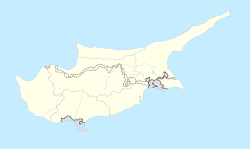Galinoporni
Galinoporni
| |
|---|---|
 View of the village of Galinoporni in 2016 | |
| Coordinates: 35°31′21″N 34°18′07″E / 35.52250°N 34.30194°E | |
| Country (de jure) | |
| • District | Famagusta District |
| Country (de facto) | |
| • District | İskele District |
| Population (2011)[2] | |
• Total | 333 |
Galinoporni (Greek: Γαληνόπορνη; Turkish: Kaleburnu) is a village in Cyprus, located on the southern side of the Karpas Peninsula. Galinoporni is under the de facto control of Northern Cyprus. As of 2011, it had a population of 333.
The village has always been exclusively populated by Turkish Cypriots.[3] It has a permanent population but is also inhabited in the summer months by villagers who emigrated to the United Kingdom as a result of the Cyprus Dispute.Cypriot Turkish is the most commonly spoken dialect, though most elderly inhabitants can speak and understand both Turkish and Greek, with some speaking Greek as a first language.[4]
The surroundings of the village host two Bronze Age sites: in Kraltepe the remains of a palace have been excavated, whose dwellers had trade contacts with the eastern coast of the Mediterranean sea around 1200 BC.[5] In Nitovikla there is a fortress dating back to 1500 BC, whose citadel has been erected in the style of the Hittitian fortress of Hattusa in Anatolia.[5] Moreover, in Avtepe there is an important group of caves.
References
- ^ In 1983, the Turkish Republic of Northern Cyprus unilaterally declared independence from the Republic of Cyprus. The de facto state is not recognised by any UN state except Turkey.
- ^ "KKTC 2011 Nüfus ve Konut Sayımı" [TRNC 2011 Population and Housing Census] (PDF) (in Turkish). TRNC State Planning Organization. 6 August 2013. Archived from the original (PDF) on 2013-11-06.
- ^ "Galinoporni". PRIO Cyprus Centre. Retrieved 11 October 2021.
- ^ Stephanie Jacobs (18 May 2020). "The miracle of Galinoporni, the Turks who spoke Cypriot Greek as a first language". Neos Kosmos. Retrieved 8 October 2021.
When the Ottomans came to the village in the 16th century, some of the men took Cypriot girls as their wives, but the girls only spoke Cypriot Greek; as such, their children learned Cypriot Greek. They were Muslims (following the religion of their fathers) but over many generations, they only spoke Cypriot Greek. This was not uncommon in Cyprus; there were numerous 'Turkish Cypriot' villages whose Muslim population spoke no Cypriot Turkish at all. Indeed, a number of travellers, and the Reports of Censuses conducted by Britain, described several such villages.
- ^ a b Braun, Ralph-Raymond (2009). Zypern (in German). Erlangen: Michael Müller. pp. 379–81. ISBN 9783899534184.


